
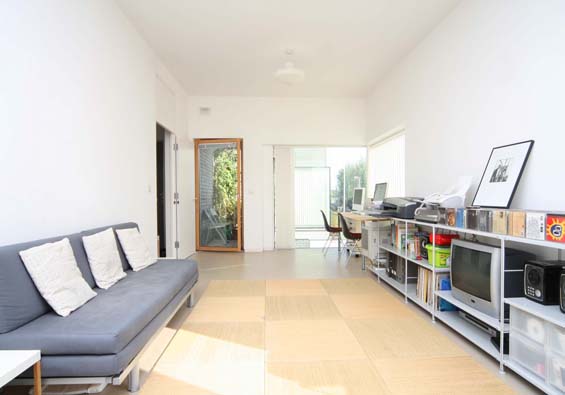
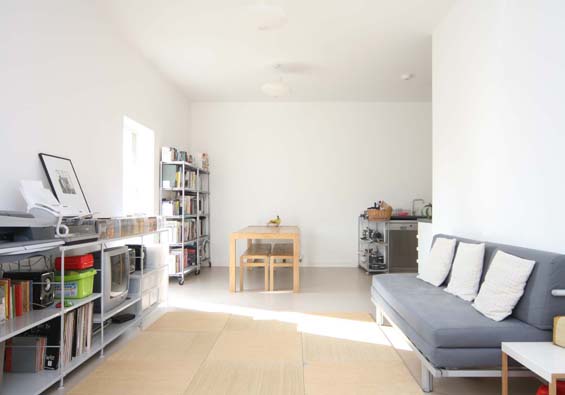
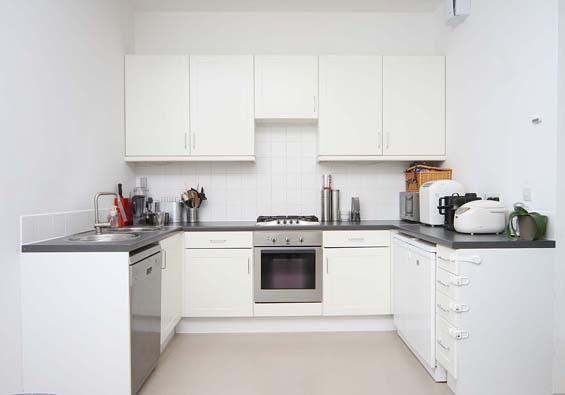

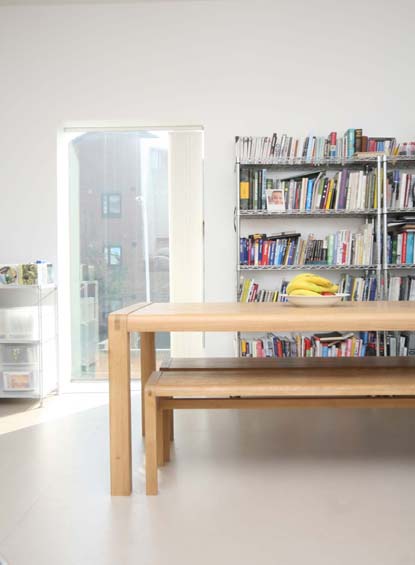
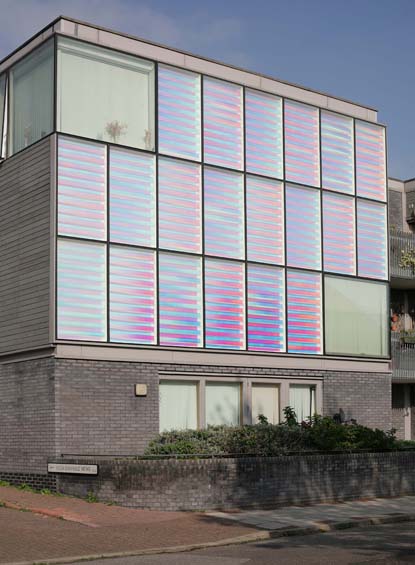
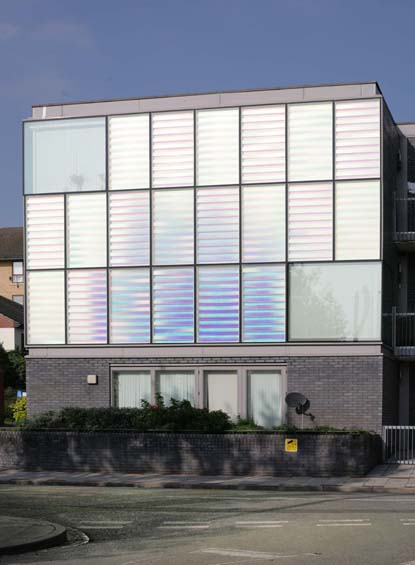
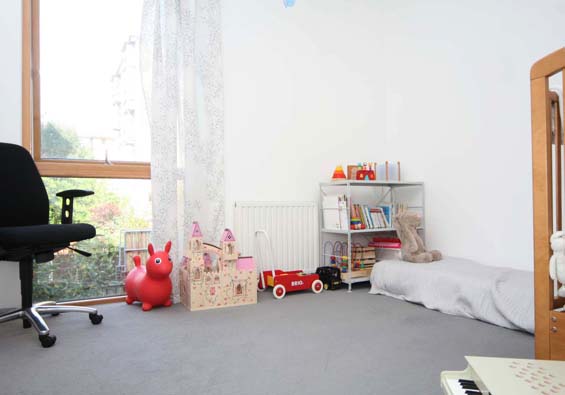
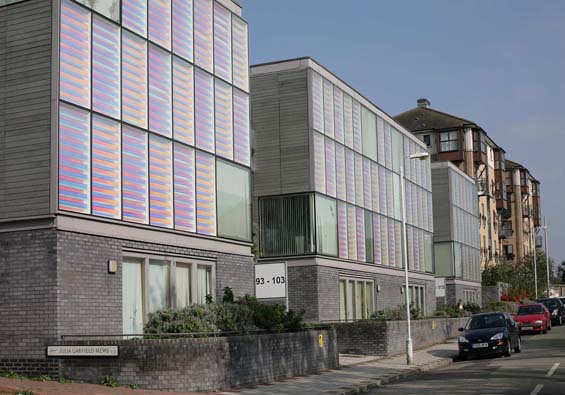
Evelyn Road, Silvertown
London E16
Architect: Níall McLaughlin
Register for similar homesA rare opportunity to purchase a large two-bedroom shared-ownership apartment in this outstanding Docklands building by Niall McLaughlin Architects. Completed in 2005, McLaughlin’s much-heralded Silvertown development was the recipient of both a Civic Trust award and an RIBA award in recognition of its architectural merit.
Offered for sale is a 75% share of the flat for a fixed price of £187,500. The remaining 25% share is owned by the Peabody Trust, which charges a subsidised rent of £106.33 per month. The new owner has the opportunity to purchase the remainder from Peabody should they wish, either immediately or at a future date.
The flat is located on the first floor, and measures approximately 828 sq ft internally. It contains two generous double bedrooms, a bathroom, and a large open-plan reception / kitchen on the south side of the building, with access to a private southwest-facing balcony. The current owners are architects, and have maintained it to a high standard.
The building contains a total of 12 flats, and is characterised by its beautiful, ever-shifting façade. The architects collaborated with the light artist Martin Richman, who
suggested using ultraviolet dichroic panels, which
produce an extraordinary rainbow of colour. For more information about this and the architecture of the development, see the History section below.
Evelyn Road is located between Royal Victoria Dock and the River Thames. West Silvertown DLR station is a short walk away. The interchange with the Jubilee Line on the Underground is just two stops away at Canning Town, and there are regular services to Bank. London City Airport is two stops to the east.
75% share
Rent: £106.33 per calendar month
Service charge: £150.70 per calendar month
Lease: 125 years from 2005
Please note that all areas, measurements and distances given in these particulars are approximate and rounded. The text, photographs and floor plans are for general guidance only. The Modern House has not tested any services, appliances or specific fittings — prospective purchasers are advised to inspect the property themselves. All fixtures, fittings and furniture not specifically itemised within these particulars are deemed removable by the vendor.




History
In October 2001, small London practices were invited by the Peabody Trust to participate in an architectural competition to design
shared-ownership homes on three sites near the Royal Victoria Dock. Peabody contacted a range of firms including members of the Society of
Black Architects, Women in Architecture, those featured in the
Architecture Foundation’s publication on New Architects and firms
shortlisted for the Young Architect of the Year award. It hoped to attract expressions of interest from practices whose
partners are from ethnic minorities as well as women-led, and
architects who work closely with artists. They limited entry to practices
with a head count of seven or less.
Under the stewardship of its director of development, Dickon Robinson, the Peabody Trust chose a scheme by Niall McLaughlin Architects for the Evelyn Road site. The practice Ash Sakula was chosen for another site, around the corner on Boxley Street.
The Evelyn Road building consists of 12 two-bedroom apartments, all of which were purchased on a shared-ownership basis. Peabody gave priority to housing association and public sector
tenants, key workers, those on council housing waiting lists and the
East London sub-regional waiting lists. (Please note that these criteria do not apply second time around – the incoming purchaser can be anyone!)
Niall McLaughlin Architects explain their design as follows:
“Modern low-cost housing construction is pre-fabricated timber frame and
timber sheeting. We imagined our building being like a row of packing
crates stacked up near the water. Once you make the timber carcass, you
have to wrap it in something. This is usually a layer of brick, or
wood, or tiles. The industrial product is returned to a reassuring
traditional appearance. For our project we looked at kinds of
industrial wrapping that might be used as the final layer of our
building. Given the site history, we wanted something bright and sweet
and chemical. It also had to be inexpensive.
“We
collaborated with light artist Martin Richman for this project; he
suggested a material called Radiant Light Film. It is produced by 3M,
who make everything from dental adhesive to Post-It notes. It has
dichroic properties so it produces iridescence. Colourless metal oxides
on the surface of the film disrupt the reflection of light, producing
interference patterns that appear as colour. As the angle of incidence
changes, the colour changes. The surface, the light source and the
viewer are in an ever-changing relationship. The 18th-century physicist
and architect Auguste Fresnel discovered this effect and explained the
phenomenon of iridescence. It appears naturally in petrol and peacock
wings.
“The south façade of the building is wrapped in a cladding of dichroic
material held in glass frames. These façade units have a 200mm depth
and contain two groups of offset louvers, the first centred within the
depth of the case, and the second on the back wall. The louvers are
fabricated from sheet acrylic, each covered in the dichroic film. Light
hitting the facade is reflected back from different layers, producing a
shifting pattern. Cast glass captures the light as it escapes. In time,
a stand of silver birch trees will add an extra layer to the facade.
They will cast shadows onto the surface and catch reflected coloured
light. At times the light effect is robustly geometric, at others it is
evanescent and fugitive. We want the building to have a dream-like
quality as though its image will not fix completely in your mind.”

